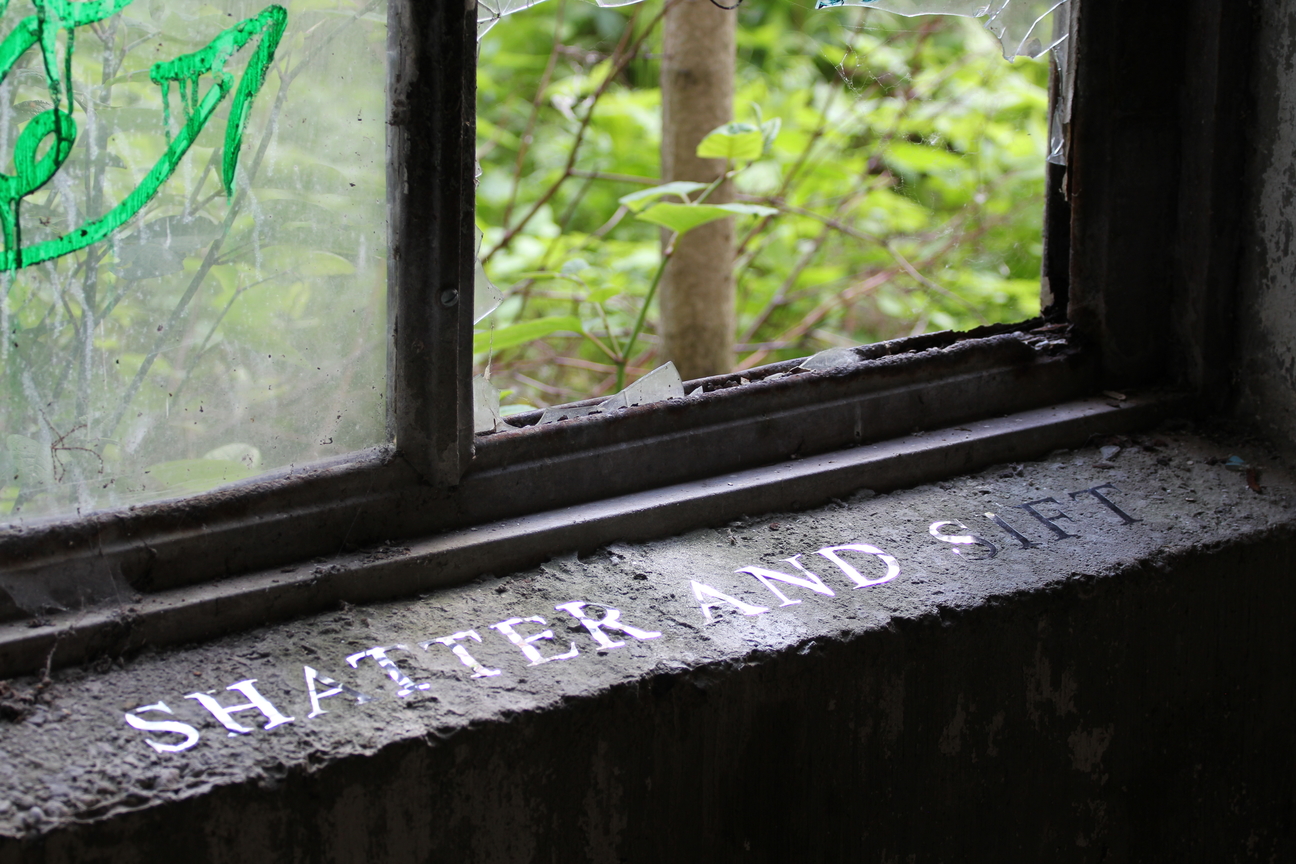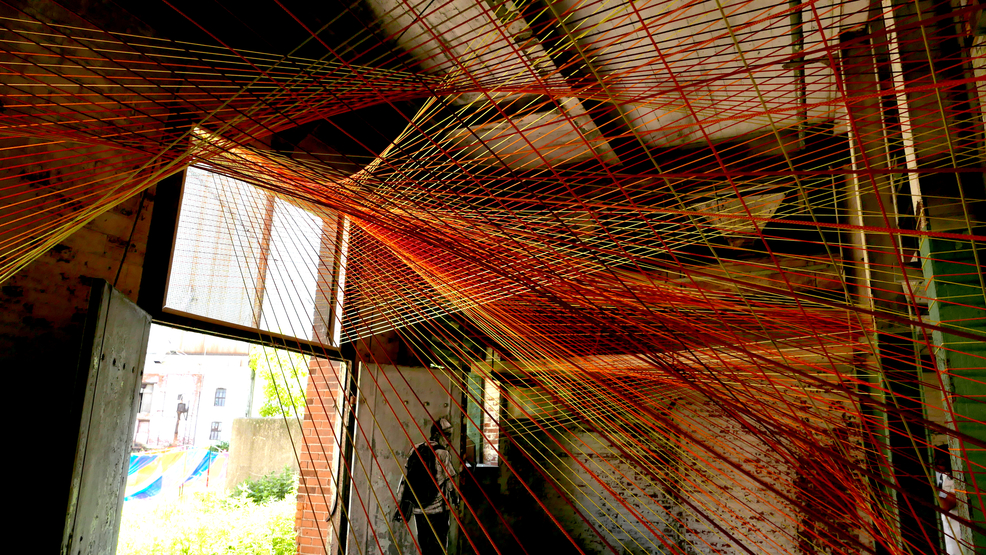Summer Solstice at Silo City
Buffalo Arts Studio Summer Solstice at Silo City 2019
Buffalo Arts Studio Summer Solstice at Silo City 2019 featured six site-specific installations by regional and national artists, including Avye Alexandres, Brandon Geissmann, Justina Dziama, Landon Moreis, Michael Camillaci, and Sara Svisco, and rhizomedas xxx: a collaboration between ALM (Andrea Lee McCullough) and SXZ (Stephen X. Zimmerer).
The installations were designed to interact with the two buildings at the north-eastern tip of the site; the Perot Grain Elevator and Malt House. The installations exist both inside and outside of the two main structures and artists took into special consideration the changing sunlight that moves over and across the site on the longest days of the year. The six artworks from the exhibition have remained on the Silo City site, enduring or deteriorating as part of the living arts and architectural experience embedded in this reclaimed industrial site.
PRESS:
Buffalo Arts Studio Summer Solstice at Silo City – Buffalo Rising

Avye Alexandres, Nowhere on Earth, 2019
Nowhere on Earth redirects viewers’ vision outwards into the spaces that surround us. Mirrors, gathered from residences in the greater Buffalo area, have been installed around the Malt House. As one passes each mirror, portions of buildings, land, and sky appear. Each vantage point creates a new composition that exists only for a moment, functioning as a live photograph. With each advancing hour, a new landscape, a new sunset, is rendered in the frame. Together, the mirrors and the buildings form an ever-changing collage of a place and time exactly here, but exactly not. Eventually even the mirrors themselves will change as the silver particles behind the glass begin to cloud and antique from the elements. As the rectangular boundaries dissolve, the images in the reflection will recede back into the texture of the buildings.
Avye Alexandres (Buffalo, NY)
Avye Alexandres was born in Athens, Greece, and moved to the United States at the age of six. Her work investigates the psychological ramifications of structures and space. Evolving from a background in photography, and theatre, her work encompasses immersive sculpture, locative media, and experimental digital narratives. In 2015 she graduated with an MFA in Art and Emerging Practices from the University at Buffalo and was the 2016 recipient of the Oseroff Memorial Purchase Award from Roswell Park Cancer Institute and CEPA Gallery. She has exhibited nationally and at venues such as the Burchfield Penney Art Center, The Soap Factory, and the Weismann Art Museum.

Brandon Giessmann, speculations ± remuneration, 2019.
speculations ± remuneration explores the existence of queer bodies inside spaces of industry and labor like Silo City. The project disperses textual interventions throughout the site, considering what navigating such hypermasculine spaces as a queer employee might have felt like. The text is composed of a reflective material, mirroring both the historic environment and the contemporary individuals visiting the space. The text oscillates between visible and invisible as it reflects its surroundings, mimicking the colors and features of both the machinery and the architecture of Silo City. As audience members wander through the space, the text is revealed or concealed based the shifting sunlight; the changing point of-view produces an individual experience that is entirely dependent on how someone moves through the space and when they do so.
Brandon Giessmann (Calgary, Alberta)
Brandon Geissmann is a Canadian visual artist and writer who explores trauma, identity, and memory. His work frequently addresses how these concepts intersect, compound, and respond to privilege. He recently graduated from Alberta University of the Arts with a BFA specializing in Print Media + Illustration, and is pursuing his MFA at the University at Buffalo. Currently his practice addresses generational discrepancies in knowledge and sexual education, the lingering effects of the (ongoing) AIDS crisis, and considers the roles institutions have played in the conservation and preservation of these histories.

Justina Dziama, A Millimeter of Space, 2019
A Millimeter of Space approaches the Perot Grain Elevator and Malt House as ruins in a post-industrial landscape. The exterior of each structure serves as a record of material transformations resulting from a lack of human intervention since the site was closed decades ago. The surface deterioration is captured in a series of hyperphysical castings fabricated from latex. Once removed, the castings forms sheets that reveal a palimpsest bearing the physical traces of continuously changing environmental conditions. The sheets are hung inside the Silo, where they function as a series of screens or shrouds directing the viewer to reexamine their own relationship with the site and the history it represents.
Justina Dziama (Buffalo, NY)
Justina Dziama is a recent graduate of the International Media Architecture Master Studies Program at the Bauhaus Universitat Weimar and the Masters of Architecture Program at the University at Buffalo. She has collaborated with media artist Stanzi Vaubel producing drawings and fabricating inflatable performance spaces for the Indeterminacy Festival and has gained professional experience in the field of architecture with the office Davidson Rafailidis, assisting with the production of stop motion animations exhibited at the Harbourfront Centre in Toronto, Cinema Ideal at the Lisbon Architecture Triennale, and BIO:50 the 2th Biennale of Design in Ljubljana, Slovenia.

Landon Moreis, Hems, 2019
American industry produces huge amounts of products that have no use once consumers deem them unfashionable. After witnessing the social, environmental, and economic injustices of mass production at an apparel factory in China, Landon Moreis decided to focus on these issues by creating artwork from recycled textiles; the raw material for Hems is the most ubiquitous American garment, a basic jersey knit t-shirt. All of the t-shirts are recycled by dissecting them into their base construction components: side seam, torso, collar, and sleeve. Moreis stitches the fragments into rings that are united to form continuous spirals that appear to float from windows. The fabric coils recall the elaborate machinery that once inhabited the Malt House, as well as swirling dust illuminated by sunbeams that stream through the western windows. Because of their placement, the color and texture of the fabric will shift over time recording the sun’s movement across the installation.
Landon Moreis (Attica, NY)
Landon Moreis was born and raised in Attica, New York and now resides in Buffalo, New York. He is currently studying Fiber Arts and Apparel Design at SUNY Buffalo State, with a focus on installation art and runway garment production. Moreis is best known for his gravity-defying, hand-stitched, fibrous sculptures that are created entirely out of recycled jersey knit t-shirts. His pieces have been exhibited at the Czurles-Nelson Gallery. Moreis is the recipient of the “John Jauquet Craft Art Design Award”, the “Arts and Humanities Dean’s Entrepreneurship Award”, and the “Nancy Belfer Fiber Design Award.”

Michael Camillaci and Sara Svisco, Solis, 2019
Solis, like the sun’s rays, bleeds into the Malt House entryway to form a dynamic field of strings that focuses movement and attention towards the building’s windows. The installation radiates from the windows, delineating which areas are intended for walking and which are intended for observing. Solis is most fully realized when an observer stands directly in front of the central south-facing window and looks up to see a field of rays originating from the sun—framed by both the window and the focal point of the installation. At this point in the installation, the symmetrical curvature of each group reflects the sun’s parabolic movement across the sky throughout the year.
Michael Camillaci and Sara Svisco (Rochester, NY and Buffalo, NY)
Michael and Sara are graduates of the State University of New York at Buffalo and each hold a Masters in Architecture. Their background is largely focused on the design of experiential forms and spaces; using innovative materials and methods, they have designed architectural installations that elevate a user’s connection with their surroundings. Collectively, their expertise is focused on ecological design and is rooted in an awareness of the measurable consequences of our actions on the environment, particularly in contemporary building techniques.

rhizomedas xxx: a design collective, Untitled (Solstice Field), 2019
On the longest day of the year, visitors to Silo City will encounter a field of translucent pennants that come to life through interaction and play. Each movement through the installation creates a kaleidoscope of colorful light and shadows resulting in a series of double images that shift as the sun traces its course. No two visitors experience this environment in the same way. Untitled (Solstice Field) invites visitors to participate in an active interaction where they can alter the space, color, and light of Silo City. Interacting with the installation produces a collaborative moment between the viewer, the architecture, and the sun, each time drawing new configurations of light and shadow.
rhizomedas xxx: a collaboration between ALM and SXZ (Philadelphia, PA)
SXZ (Stephen X. Zimmerer) and ALM (Andrea Leigh McCullough) are a collaborative artist team focused on the power of design to spark interaction, deliver unfamiliar experience, and tell stories of transformative togetherness. The team directs rhizomedas xxx, a design collective dedicated to creating and curating interdisciplinary artwork and design. Based digitally, the pair maintains a collaborative space online, drawing together regularly in a shared language cultivated by seven years of collaboration and friendship. In its first season of work, rhizomedas xxx muses upon human separateness—and how multi-species kinship, kinetics, and interaction can bridge divides of separation—through speculative garden design.

